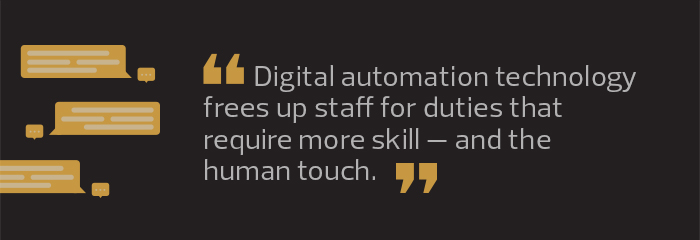Hello, I’ll Be Your Chatbot Today. How Can I Help You?
The U.S. Army’s Sgt. Star deployed in 2006, one of the first chatbots to see action on the front lines of government customer service. Since then, he’s been joined by Emma, Washington and an ever-increasing number of other automated processes designed to ease the human workload.
Whether the goal is to triage common questions and requests, process simple trouble tickets, manage human resources paperwork or other repetitive tasks, digital automation technology frees up staff for duties that require more skill — and the human touch.
“The nice thing about a robot is that it can run 1,440 minutes a day. If you have a process that takes 30 seconds, you can do the math and know that you can run 2,880 processes, all day long,” says Jim Walker, the recently retired shared services portfolio manager for NASA’s Shared Services Center.
SIGN UP: Get more news from the FedTech newsletter in your inbox every two weeks!
Chatbots Fill in for Humans in Answering Queries
Sgt. Star serves as an automated FAQ for potential recruits who all need the same basic information. They can click on more than 20 questions or type a question into a box; the chatbot pops up with the answer, as well as links to more information.
Since his introduction, Sgt. Star has done the work of 55 human recruiters, answering more than 16 million questions with an accuracy rate of 94 percent.
The chatbot is a more engaging and personal way for the Army to connect with its young recruits — user engagement time increased from four to 10 minutes once Sgt. Star was deployed.

At U.S. Citizenship and Immigration Services, virtual assistant Emma has guided 4.5 million English speakers (and 805,000 Spanish speakers) who need help with immigration issues. When a user types a question into the box, the answer, with helpful links, appears on the screen. The nearly 17 million questions asked of Emma since 2015 have also let the agency know about new areas of interest among users, and the assistant has been updated accordingly.
“Emma’s knowledge level continually improves over time,” says Marilu Cabrera, a public affairs officer at USCIS. “Every new question helps our team improve her responses.”
Agencies Can Use Bots to Help with Office Tasks
Not all automated “employees” are customer-facing. At NASA’s Shared Services Center, a robotic process automation named Washington manages email, populates fields in forms, relocates system folders, triggers programmatic responses and completes other rote, rules-based tasks. It even has its own email address and systems permissions.
The result of a 2016 design competition among NASA employees, Washington has triggered other pilot projects that lend themselves to similar automation. “Within the past 3 months, NSSC has completed five to six new automations, with over 60 new ideas being assessed, and over 170 in the queue” says Pamela Wolfe, chief of the enterprise services division in NASA’s Shared Services Center.
Other agencies testing ways to offload routine work onto automation and bots include the Treasury Department, the General Services Administration and the Veterans Affairs Department.
“These bots are designed to perform the mundane work that no one goes home at night and says they were proud they did. When our employees go home, they talk about the complex, important, person-to-person problems that they solved,” Walker says.








